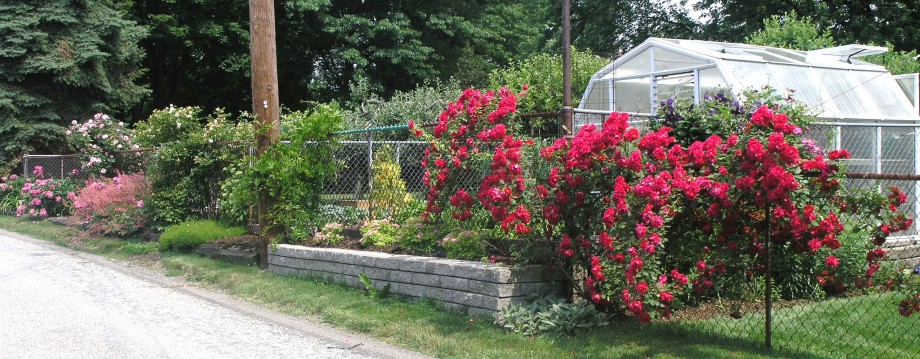Having no formal education in gardening I am always questioning what I do. Recently there was a discussion on one of the forums about vermiculite. I do not remember the specifics about the discussion but it led me to this inquiry.
I had sent this email to the Schundler Co. the largest vermiculite/pearlite producer on the east coast.
Hi my name is John and I have used vermiculite extensively in the garden and a hobby greenhouse. I have read that vermiculite does not breakdown do they mean chemically or structurally? After about three years I cannot find any of it. Should I be replacing it after so many years?
This is their response.
It is a “soft” rock which is to say it may have just been crushed to the point that you don’t recognize it. For aeration and water retention you should replenish it.
Now I get in trouble it got me to thinking. I have put literally tons upon tons of compost on my garden every year for 36 years. After all that time and compost the height of my garden has not changed. This leads me to believe that when compost is totally decomposed it must be about as thick as a layer of dust. Also I have learned that it takes a very long time for peat moss to decompose. Some of my friends from the forums are SFG purest and justly so they use the recommended mix of 1/3 peat 1/3 vermiculite and 1/3 compost with very excellent results. Can I assume if I had a 6” raised bed and filled it with the recommended mix and did not top dress it for 3 to 4 years I would end up with about 2” of peat with just a residue of compost and vermiculite? If this is true then shouldn’t you top-dress with a mixture of 50% compost and 50% vermiculite and blend/till it with the remaining mix from the previous year to maintain the integrity of the SFG?
Any comments to set my thinking straight would be appreciated
John


I was thinking about this myself. Only, in my case, my mix shinks by around 25% during the season (compacts? washes off? No idea…). Also, though, I lose soil when I remove crop roots. Maybe I’m just not that great at shaking it all off, but I don’t seem to collect it all and I’ve heard that it’s not so great to compost tomatoes, so, I lose some. Bartholomew says just to add more compost when you pull your crops, and that’s what I’ve been doing. Doesn’t that seem to make the natural end to the whole thing that you end up with a straight compost mix?
LikeLike
John, you probably already know I’m presonally biased toward vermiculite because I need to justify spending so much to fill my beds. However, I am the first to conceed that it is not necessary for a successful garden.
That said, I am kind of surprised that it would break down then I’ve read so often that it doesn’t. I for one will think long and hard before adding more vermiculite to my garden.
I haven’t had my garden long enough to say if it goes away or not, but you’d think Mel would say it does since he has had his garden for decades. Is it possible that the vermiculite manufacturer you contacted just wanted to sell more product? I think the truth is probably a little of both. For that matter, have you found that peat doesn’t decompose? If it does, then over time you would end up with 100% compost. Wouldn’t that be a shame.
Definitely worth more investigation, especially when I dig into my garden in the spring. Food for thought.
LikeLike
Carolyn, I never pull the roots out, I cut the stock at ground level. The beneficial fungi are collimated in the roots and you want them left in the soil. I have composted tomatoes for fifty years with no problems. I do not know about the soil, maybe it would be like a semi lasagna style. It would be interesting if someone that has been SFGing for some years would take a core sample with a piece of tubing and look.
John
LikeLike
Sinfonian, When I start thinking, is when I get in trouble. What started me is when tilling in the fall, I would see traces of vermiculite from the annuals. However, if I transplanted a perennial that has been in the ground for some years, there is no trace of it.
John
LikeLike
Hi John — I have 2 raised beds that are 2’x8′ — they are probably 4 or 5 years old now. I can’t see the vermiculite in them anymore. I’ve read somewhere before that you have to replenish the vermiculite every couple of years because it is a soft rock and does continue to break down into smaller and smaller pieces.
Also, Mel recommends using “coarse” vermiculite. So far the only kind that I’ve found is the “medium”. So I imagine that since mine is smaller to begin with, it doesn’t take as long for it to break down into even small pieces.
I will be adding vermiculite to my old 2’x8′ raised beds this spring.
LikeLike
This information is very interesting…..I wouldn’t know the answer, because my beds are less than a year old. I will probably add more vermiculite in another year or two, just to make sure the moisture retention properties of the mix are kept at an ideal level. Thanks for posting this, John….
EG
LikeLike
This is the first I have heard of this, but it makes sense. Did the supplier mention how often one should replenish the vermiculite?
LikeLike
Makes sense…Did the supplier say how often you should put more vermiculite in?
LikeLike